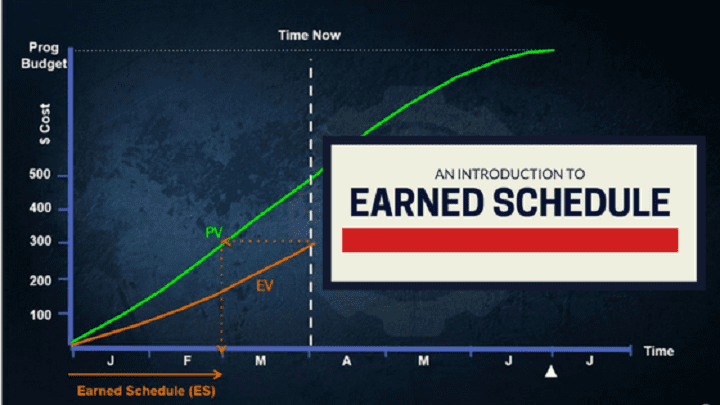Earned Value Management (EVM) is a powerful tool for evaluating the schedule and cost performance of projects and predicting future results. However, existing earned value schedule performance metrics does not do a good job with schedule performance evaluation and prediction.
Use of “Earned Schedule” enhances the earned value management ’s ability to better represent and forecast schedule information. Watch this video training to learn how:
Download the free audio mp3 podcast of this episode on iTunes.
Want more training? Subscribe to Project Control Academy to receive complimentary training videos and resources delivered to your mailbox.
Project Control Quotes to Consider: Join Project Control Academy on Instagram for tons of great quotes.
Video Transcript:
Earned Value Management (EVM) is a powerful tool for evaluating the schedule and
cost performance of projects and predicting future results. However, existing earned value schedule performance metrics (SPI & SV) does not do a good job with schedule performance evaluation and prediction. The reason is two fold:
1. EVM Units of Measure Are Usually Currency, Not Time Units
EVM metrics are measured in units of currency, typically dollars, and that produces variances in dollars, which is useful from a budget regaining perspective, but not necessarily the schedule.
SV($)=EV($)-PV($)=$…
SPI & SV are very often misinterpreted as a time-based indicator, for example, are we early or late and by how much?
SPI & SV are not time-based indicators, but rather an indication of the physical status (how much of the work has been accomplished as compared to the planned work).
You cannot use cost ($) to speak about time units, the amount of delays (duration), or the reason for the delay.
That’s why the EVM scheduling metrics are not used to estimate the project completion date.
2. EVM Scheduling Metrics Are Not Reliable Toward the End of the Project
Another issue with the EVM scheduling metrics is that they fail toward the end of the project.
The schedule indicators initially appear to establish a trend at the beginning of the project. However, at some point around 2/3 into the project the SPI begins to become meaningless.
The reason is that at the end of the project the earned value will be equal to the planned value, which results in SPI of 1 and SV of zero.
EV= % x Budget (BAC)
At the end of the project, EV= 100%x BAC= BAC
At the end of the project, PV= BAC
Therefore, at the end of the project, EV= PV and as a result, SV=0 and SPI=1
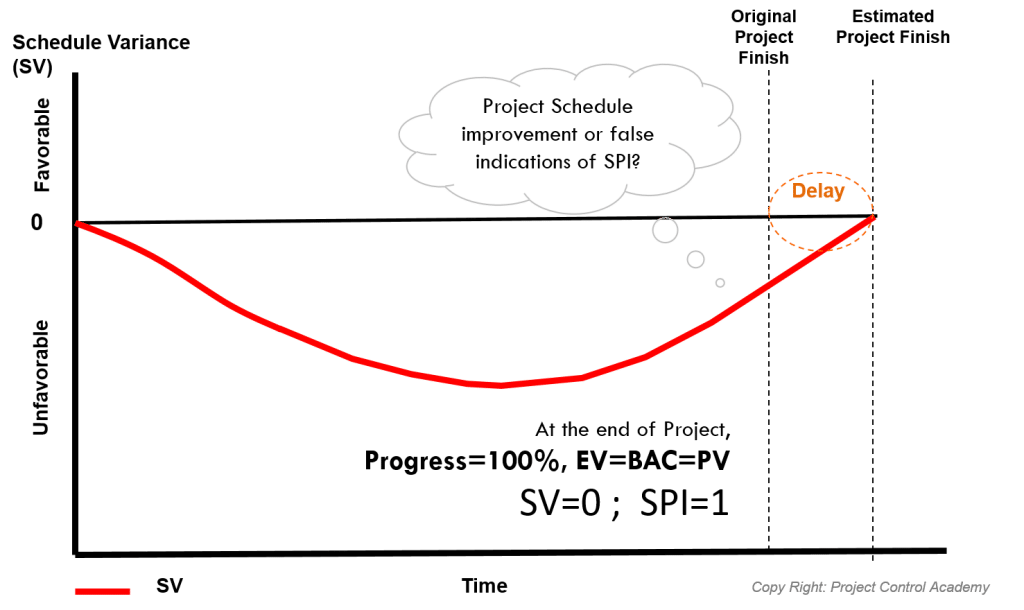
This indicates that at the end of the project, regardless of how early or late the project completes, the EVM scheduling metrics shows perfect on-schedule performance.
This quirky behavior of SV and SPI occurs for every project approaching the finish line, no matter how early or late.
So, what can be done?
Ignore the EVM scheduling metrics all together?
Well, this is what most Project Managers do. They pay much more attention to cost metrics than they do for the schedule.
However, this ignoring the EVM scheduling metrics doesn’t solve the problem either. There are several ways to enhance the reliability and accuracy of the EVM scheduling metrics.
One of the newly emerged methods is the “Earned Schedule”.
In this training, I am going to introduce you to concept of “Earned Schedule”, so you know how you can use Earned Schedule metrics to assess and predict the schedule performance.
Earned Schedule
Earned schedule is a new concept developed by Walt Lipke in 2003. Now Earned Schedule (ES) is an appendix in PMI Practice Standard for Earned Value Management and is considered as an extension to the EVM practice.
Although the knowledge and use of ES has grown immensely and spread globally over the last decade, the method remains unknown to many EVM practitioners.
I believe the Earned Schedule is a very simple concept. It is not difficult to grasp. There is almost insignificant effort required to add and utilize the capabilities offered by the Earned Schedule.
I encourage you to use the Earned Schedule metrics in your next EVM project and evaluate the outcomes as compared to the traditional EVM scheduling metrics.
Earned Schedule vs. Earned Value
The idea of Earned Schedule is analogous to Earned Value. However, instead of using cost ($) for measuring schedule performance, it uses time.
Rather than just looking at schedule performance using the $ value of work accomplished as compared with the plan, the Earned Schedule looks at when the work was supposed to be completed.
Let’s examine the concept of the Earned Schedule through a simple example.
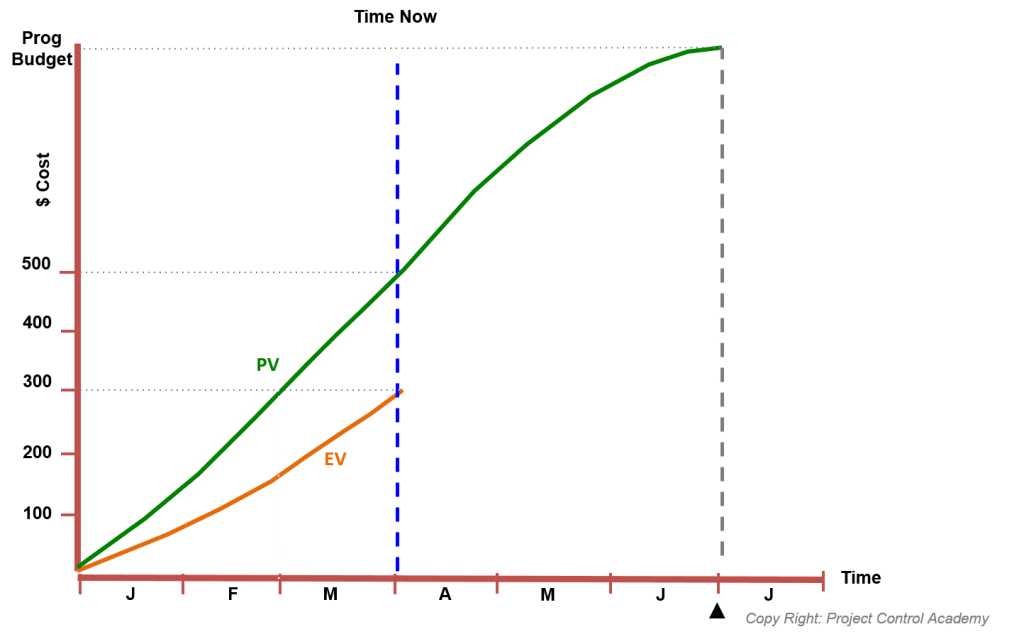
EV= $300
PV= $500
SV($)= EV-PV= -$200
SPI($)=EV/PV=0.6
Now, to measure Earned Schedule, we need to determine “when” the work was supposed to be earned.
In other words, at what point in time was the current Earned Value (EV) should have been occurred?
This is determined by crossing a horizontal line from the current cumulative EV to the PV curve. The intersection of this line with the PV curve is the Earned Schedule.
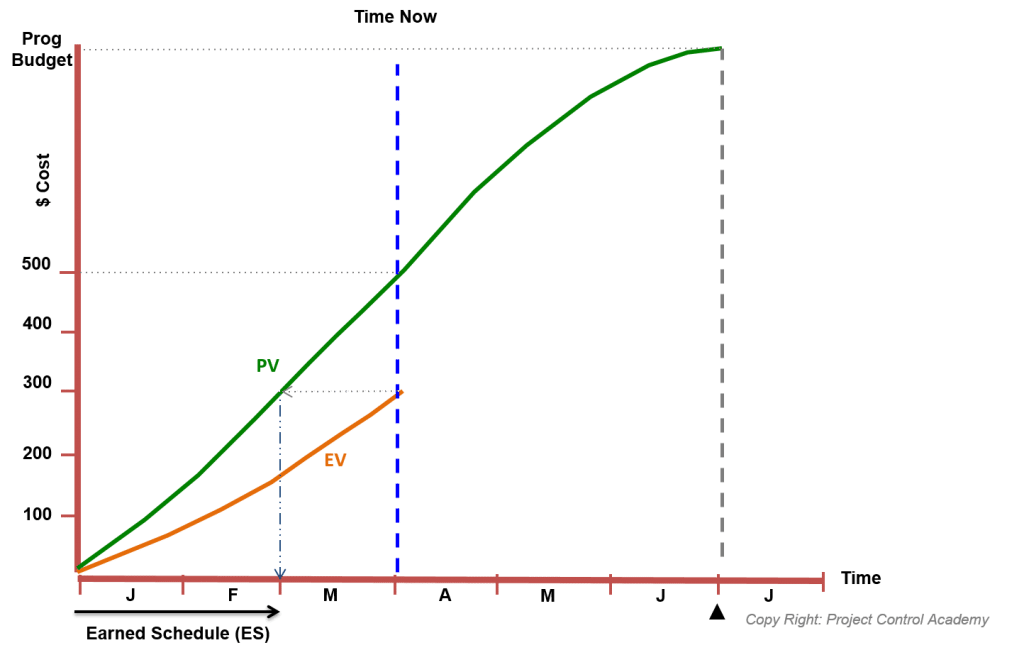
In this example, Earned Schedule is 2 months.\
Therefore, Earned schedule (ES) is the point in time when the current earned value was to be accomplished. It is the point at which the project PV supposed to be equal to the current EV.
There are other terms that you need to know:
Actual Time (AT):
The other new parameter is the Actual Time (AT), which is the number of periods executed since the time the project started.
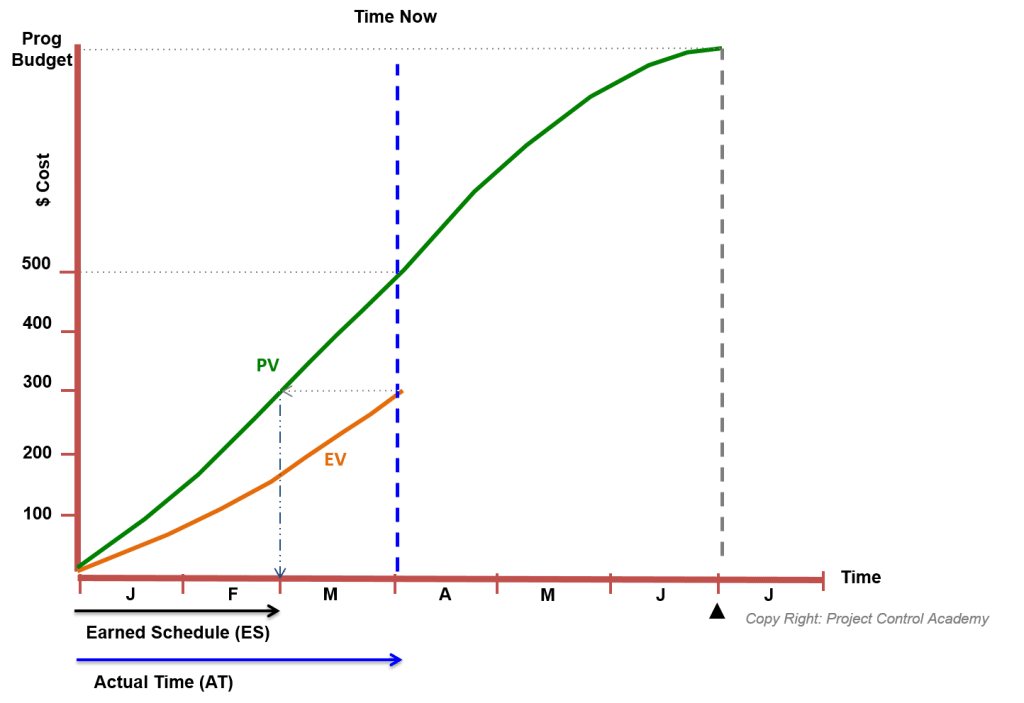
In our example, the total number of periods executed from the beginning of the project is 3 months. Therefore, Actual Time (AT) is 3 months.
Planned Duration (PD):
Another new terminology is the Planned Duration (PD), which is the “original duration of the project”.
What is the PD in our example?
That’s right. It is 6 months.
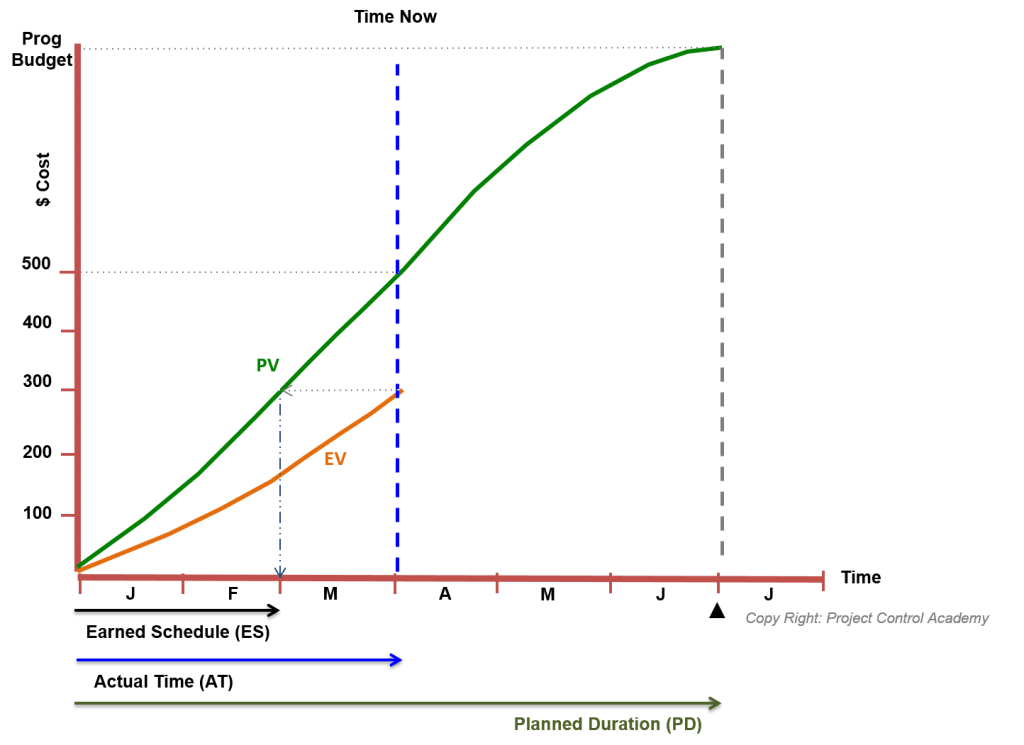
Now we have 3 key elements to assess the schedule status in units of time:
- Earned Schedule (ES)
- Actual Time (AT)
- Planned Duration (PD)
Similar to the traditional EVM metrics, new ones can be generated for schedule performance.
SV(t)= ES- AT
SPI(t)= ES/AT
To distinguish between the traditional EVM metrics and Earned Schedule metrics, a “t” representing time is added in Earned Schedule metrics.
Going back to the example used, let’s examine the schedule variance and schedule performance index:
SV(t)= ES-AT= 2-3= -1 month
SPI(t)= ES/AT= 2/3= 0.67
Like our traditional SV & SPI, a negative SV and a less than 1 SPI shows a behind schedule status.
However, here you are measuring the Schedule Variance with units of time instead of $.
In this example, we are one month behind schedule and the schedule performance index shows that for every hour worked on the job, we were only 0.67 hour (40 min) productive in accomplishing the work planned.
Do you recall the issue with the SPI($) and SV($) at the end of the project?
Do you think this issue is resolved with the SPI(t) and SV(t)?
Let’s assume that our project completes in the month of September (month 9) and our total approved budget is $1M at the time of project completion.
According to this information:
At the end of the project:
EV=100%x Budget= $1M
PV= Budget (BAC)= $1M
ES=PD=6 months
AT= 9 months
Therefore…
SV($)= EV-PV=0 SV(t)= ES-AT=6-9=-3 month
SPI($)=EV/PV=1 SPI(t)= ES/AT= 6/9= 0.67
The important observation is that SPI(t) & SV(t) remained good indicators of project status while the SPI($) & SV($) ended up at 1.0 & zero respectively regardless of 3-month late completion of the project.
In addition to schedule performance metric, similar to the cost forecasting metrics, schedule forecasting metrics can be utilized to forecast the schedule completion date (e.g. To Complete Schedule Performance Index (TSPI), Estimated Time at Completion (EAC(t)) and Variance at Completion (VAC(t)).
More information on the Earned Schedule metrics and formulas will be covered in another training.
In summary, use of Earned Schedule enhances the earned value management’s ability to accurately represent and forecast schedule information.
I hope this training raised your curiosity in the use and application of the Earned Schedule in your projects and provided you a new means to justify your misbehaving SPI ($) and SV($) toward the end of the project.
About the Author, Shohreh Ghorbani
 Shohreh is the founder and director of Project Control Academy, the leading provider of comprehensive online training programs in Project Controls. Shohreh has served tens of thousands of professionals and several international corporations build their technical Project Controls knowledge and shave off years of trial and error in learning the vital skills in controlling their projects.
Shohreh is the founder and director of Project Control Academy, the leading provider of comprehensive online training programs in Project Controls. Shohreh has served tens of thousands of professionals and several international corporations build their technical Project Controls knowledge and shave off years of trial and error in learning the vital skills in controlling their projects.
Shohreh is a licensed project management professional (PMP) recognized by Project Management Institute (PMI) and holds a Master of Science in Industrial Engineering.
Connect with Shohreh via Facebook, Linkedin, Google+, Instagram, iTunes, YouTube

